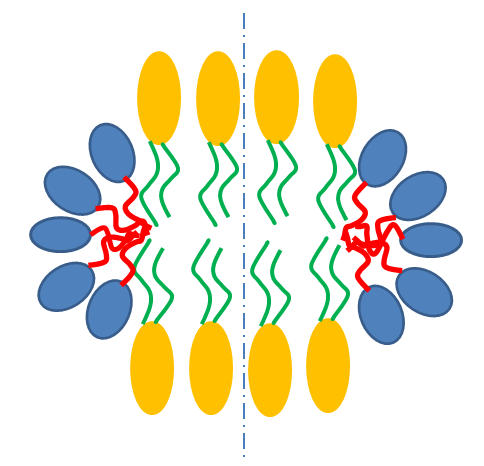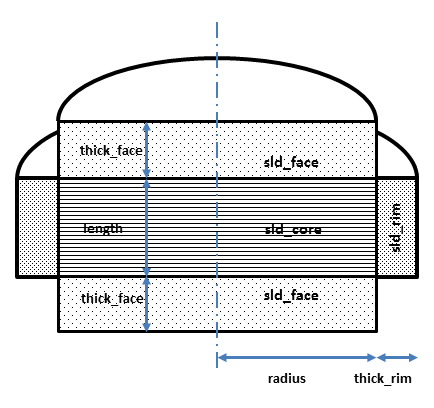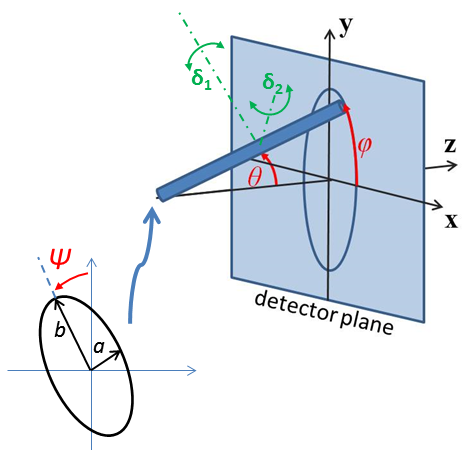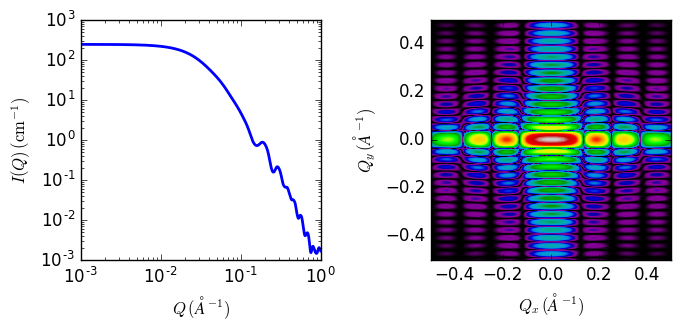core_shell_bicelle_elliptical_belt_rough
Elliptical cylinder with a core-shell scattering length density profile..
| Parameter | Description | Units | Default value |
|---|---|---|---|
| scale | Source intensity | None | 1 |
| background | Source background | cm-1 | 0.001 |
| radius | Cylinder core radius r_minor | Å | 30 |
| x_core | Axial ratio of core, X = r_major/r_minor | None | 3 |
| thick_rim | Rim or belt shell thickness | Å | 8 |
| thick_face | Cylinder face thickness | Å | 14 |
| length | Cylinder length | Å | 50 |
| sld_core | Cylinder core scattering length density | 10-6Å-2 | 4 |
| sld_face | Cylinder face scattering length density | 10-6Å-2 | 7 |
| sld_rim | Cylinder rim scattering length density | 10-6Å-2 | 1 |
| sld_solvent | Solvent scattering length density | 10-6Å-2 | 6 |
| sigma | Interfacial roughness | Å | 0 |
| theta | Cylinder axis to beam angle | degree | 90 |
| phi | Rotation about beam | degree | 0 |
| psi | Rotation about cylinder axis | degree | 0 |
The returned value is scaled to units of cm-1 sr-1, absolute scale.
Definition
This model provides the form factor for an elliptical cylinder with a core-shell scattering length density profile. Thus this is a variation of the core-shell bicelle model, but with an elliptical cylinder for the core. In this version the “rim” or “belt” does NOT extend the full length of the particle, but has the same length as the core. Outer shells on the rims and flat ends may be of different thicknesses and scattering length densities. The form factor is normalized by the total particle volume. This version includes an approximate “interfacial roughness”.

Fig. 15 Schematic cross-section of bicelle with belt. Note however that the model here calculates for rectangular, not curved, rims as shown below.

Fig. 16 Cross section of model used here. Users will have to decide how to distribute “heads” and “tails” between the rim, face and core regions in order to estimate appropriate starting parameters.
Given the scattering length densities (sld) \(\rho_c\), the core sld, \(\rho_f\), the face sld, \(\rho_r\), the rim sld and \(\rho_s\) the solvent sld, the scattering length density variation along the bicelle axis is:
The form factor for the bicelle is calculated in cylindrical coordinates, where \(\alpha\) is the angle between the \(Q\) vector and the cylinder axis, and \(\psi\) is the angle for the ellipsoidal cross section core, to give:
where a numerical integration of \(F(Q,\alpha, \psi)^2\sin(\alpha)\) is carried out over \(\alpha\) and \(\psi\) for:
where
and \(V_t = \pi (R+t_r)(X_\text{core} R+t_r) L + 2 \pi X_\text{core} R^2 t_f\) is the total volume of the bicelle, \(V_c = \pi X_\text{core} R^2 L\) the volume of the core, \(V_{c+f} = \pi X_\text{core} R^2 (L+2 t_f)\) the volume of the core plus the volume of the faces, \(V_{c+r} = \pi (R+t_r)(X_\text{core} R+t_r) L\) the volume of the core plus the rim, \(R\) is the radius of the core, \(X_\text{core}\) is the axial ratio of the core, \(L\) the length of the core, \(t_f\) the thickness of the face, \(t_r\) the thickness of the rim and \(J_1\) the usual first order bessel function. The core has radii \(R\) and \(X_\text{core} R\) so is circular, as for the core_shell_bicelle model, for \(X_\text{core}=1\). Note that you may need to limit the range of \(X_\text{core}\), especially if using the Monte-Carlo algorithm, as setting radius to \(R/X_\text{core}\) and axial ratio to \(1/X_\text{core}\) gives an equivalent solution!
An approximation for the effects of “Gaussian interfacial roughness” \(\sigma\) is included, by multiplying \(I(Q)\) by \(\exp\left \{ -\frac{1}{2}Q^2\sigma^2 \right \}\). This applies, in some way, to all interfaces in the model not just the external ones. (Note that for a one dimensional system convolution of the scattering length density profile with a Gaussian of standard deviation \(\sigma\) does exactly this multiplication.) Leave \(\sigma\) set to zero for the usual sharp interfaces.
The output of the 1D scattering intensity function for randomly oriented bicelles is then given by integrating over all possible \(\alpha\) and \(\psi\).
For oriented bicelles the theta, phi and psi orientation parameters will appear when fitting 2D data, for further details of the calculation and angular dispersions see Oriented particles .

Fig. 17 Definition of the angles for the oriented core_shell_bicelle_elliptical particles.

Fig. 18 1D and 2D plots corresponding to the default parameters of the model.
References
| [1] |
Authorship and Verification
- Author: Richard Heenan Date: October 5, 2017
- Last Modified by: Richard Heenan new 2d orientation Date: October 5, 2017
- Last Reviewed by: Richard Heenan 2d calc seems agree with 1d Date: Nov 2, 2017